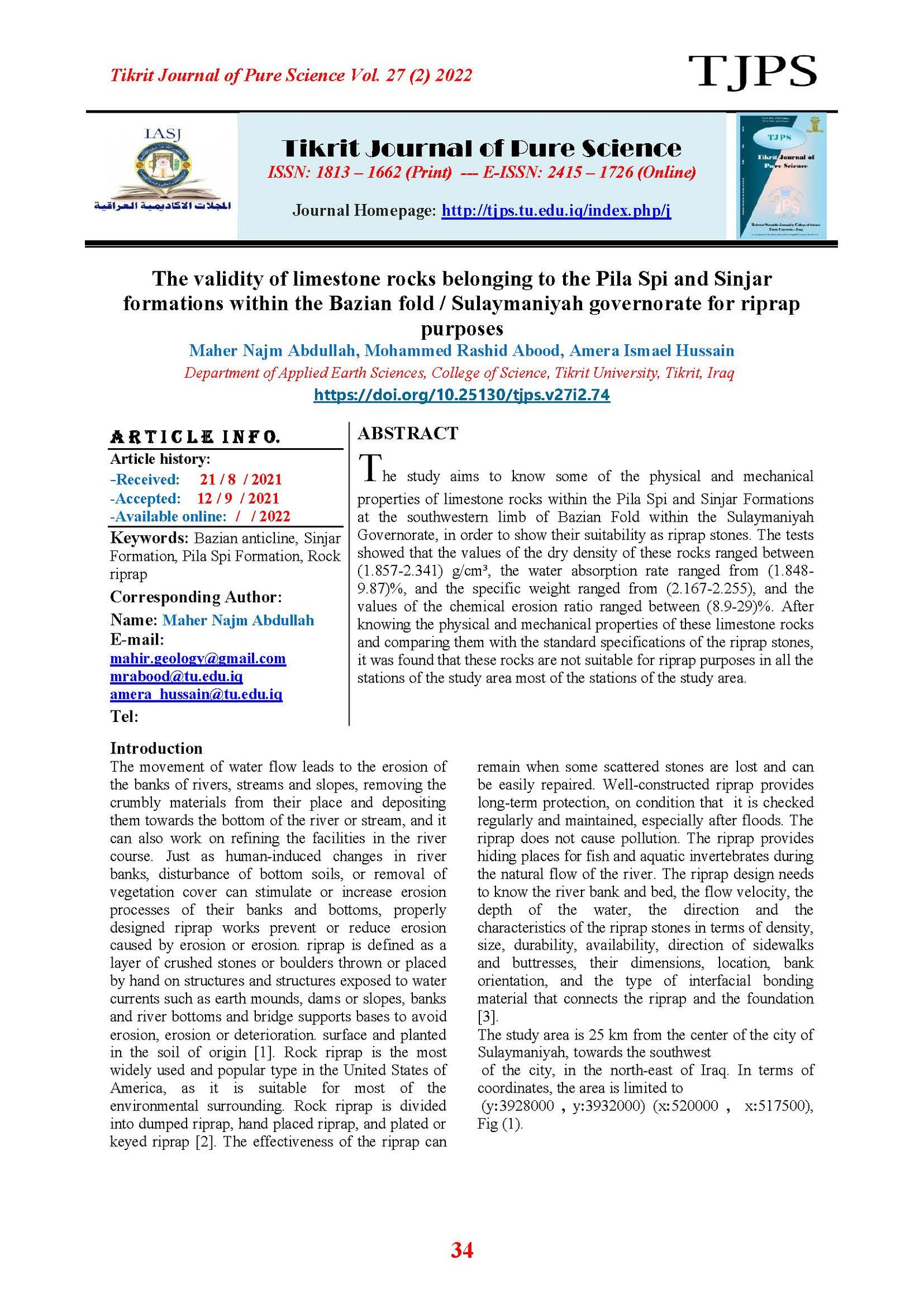The validity of limestone rocks belonging to the Pila Spi and Sinjar formations within the Bazian fold / Sulaymaniyah governorate for riprap purposes
Main Article Content
Abstract
The study aims to know some of the physical and mechanical properties of limestone rocks within the Pila Spi and Sinjar Formations at the southwestern limb of Bazian Fold within the Sulaymaniyah Governorate, in order to show their suitability as riprap stones. The tests showed that the values of the dry density of these rocks ranged between (1.857-2.341) g/cm³, the water absorption rate ranged from (1.848-9.87)%, and the specific weight ranged from (2.167-2.255), and the values of the chemical erosion ratio ranged between (8.9-29)%. After knowing the physical and mechanical properties of these limestone rocks and comparing them with the standard specifications of the riprap stones, it was found that these rocks are not suitable for riprap purposes in all the stations of the study area most of the stations of the study area.
Article Details

This work is licensed under a Creative Commons Attribution 4.0 International License.
Tikrit Journal of Pure Science is licensed under the Creative Commons Attribution 4.0 International License, which allows users to copy, create extracts, abstracts, and new works from the article, alter and revise the article, and make commercial use of the article (including reuse and/or resale of the article by commercial entities), provided the user gives appropriate credit (with a link to the formal publication through the relevant DOI), provides a link to the license, indicates if changes were made, and the licensor is not represented as endorsing the use made of the work. The authors hold the copyright for their published work on the Tikrit J. Pure Sci. website, while Tikrit J. Pure Sci. is responsible for appreciate citation of their work, which is released under CC-BY-4.0, enabling the unrestricted use, distribution, and reproduction of an article in any medium, provided that the original work is properly cited.
References
[1] Ippen, A.T. and Drinker, p.(1962). “Boundary Shear Stresses in Curved Trape, zooidal channels,” Journal of the Hydraulics Division, ASCE, 88 HY5 , PP.143-179.
[2] Bown ,S.A. and Clyde,E.S. (1989). “Design of riprap Revetment” Hydraulic Engineering Circular NO.11 (HEC-11), Report FHWA-IP-89-016, Federal Highway Adminstration, Washington, D.C.
[3] P.F., Lagass, P.E., L.W., Zevenbergen, J.F., Ruff. (2006). NCHRP REPORT 568:riprap Design Criteria, Reccommnded, Specifications, and Quality Control NATIONAL COOPERATIVE HIGHWAY, RESEARCH PROGRAM TRANSPORTATION RESEARCH BOARD,. WASHINTON, D.C
[4] HAMASUR,GHAFOR AMEEN (2009). Rock Mass Engineering of the proposed basara dam site sulaimanni Kurdistan region, NE-Iraq, Doctorate thesis, University of Sulaymaniyah, College of Science,182p.
[5]Fattohi, Zuhair Ramo and Thabet, Kenana Muhammad and Jassar, Sinan and Mashkoor, Mustafa (1989): Engineering geology and on-site investigation, Directorate of Dar al-Kutub, University of Mosul, 352 p.
[6] Scott, C. R., 1974: An Introduction to Soil Mechanics and foundations, 2th ed., Applied science, Ripple Road, Essex, England, 361 p.
[7] ASTM- C, 97-09., (2010) “Standard test methods for absorption and Bulk specific gravity of Dimension stone”3p..
[8] Griffin , J. A., (2008): development of a rating classification for rock to be used as toe - bench material, Master thesis ,kent state university,131p
[9] ASTM-C88.,(2018):Standard Test Method for Soundness of Aggregates by Use of Sodium Sulfate or Magnesium Sulfate1,5p.
[10] ASTM, D-523,2004. Material specification, (Rock for riprap)
